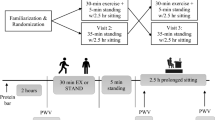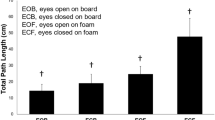Abstract
Purpose
Standing workstations have recently been promoted as a healthy alternative to sitting. However, it is unknown how prolonged standing affects arterial stiffness, a prognostic indicator of cardiovascular health. The purpose of this study was twofold: to observe changes in arterial stiffness, as assessed by pulse wave velocity (PWV), with a 2-h bout of standing, and to determine if short, intermittent walking bouts provide a comparative advantage to standing alone.
Methods
Nineteen adults had arterial stiffness assessed by pulse wave velocity. Central (CPWV), upper peripheral (UPWV), and lower peripheral (LPWV) PWV were assessed before (supine), during standing (min 10, 60, and 120), and after (supine) the 2-h standing bout. In one trial, the participants stood at a standing desk immobile for 2 h. In the other trial, participants performed 5-min walking breaks after every 25 min of standing.
Results
After 2-h of standing, supine (85.8 ± 90.1 cm/s) and standing (303.4 ± 390.2 cm/s), LPWV increased independent of trial (i.e., main effect of time; p < 0.001). Walking breaks during 2 h of standing did not significantly attenuate these changes. In addition, standing CPWV decreased over time (− 38.5 ± 61.5 cm/s; p = 0.04). Yet, UPWV, standing or supine, did not change over the course of standing (p > 0.05).
Conclusions
These findings indicate that prolonged standing increases the measures of arterial stiffness and there is no evidence that walk breaks attenuate this response.




Similar content being viewed by others
Abbreviations
- C PWV :
-
Central pulse wave velocity
- HR:
-
Heart rate
- L PWV :
-
Lower peripheral pulse wave velocity
- MAP:
-
Mean arterial pressure
- PWV:
-
Pulse wave velocity
- STAND:
-
Standing trial
- U PWV :
-
Upper peripheral pulse wave velocity
- WALK:
-
Walking trial
References
Agarwal S, Steinmaus C, Harris-Adamson C (2018) Sit-stand workstations and impact on low back discomfort: a systematic review and meta-analysis. Ergonomics 61(4):538–552. https://doi.org/10.1080/00140139.2017.1402960
Ashor AW, Lara J, Siervo M et al (2014) Effects of exercise modalities on arterial stiffness and wave reflection: a systematic review and meta-analysis of randomized controlled trials. PLoS ONE 9:e110034. https://doi.org/10.1371/journal.pone.0110034
Ben-Shlomo Y, Spears M, Boustred C, May M, Anderson SG, Benjamin EJ, Boutouyrie P, Cameron J, Chen CH, Cruickshank JK, Hwang SJ, Lakatta EG, Laurent S, Maldonado J, Mitchell GF, Najjar SS, Newman AB, Ohishi M, Pannier B, Pereira T, Vasan RS, Shokawa T, Sutton-Tyrell K, Verbeke F, Wang KL, Webb DJ, Willum Hansen T, Zoungas S, McEniery CM, Cockcroft JR, Wilkinson IB (2014) Aortic pulse wave velocity improves cardiovascular event prediction: an individual participant meta-analysis of prospective observational data from 17,635 subjects. J Am Coll Cardiol 63(7):636–646. https://doi.org/10.1016/j.jacc.2013.09.063
Brothers RM, Wingo JE, Hubing KA, Del Coso J, Crandall CG (2009) Effect of whole body heat stress on peripheral vasoconstriction during leg dependency. J Appl Physiol 107(6):1704–1709. https://doi.org/10.1152/japplphysiol.00711.2009
Calabia J, Torguet P, Garcia M, Garcia I, Martin N, Guasch B, Faur D, Valles M (2011) Doppler ultrasound in the measurement of pulse wave velocity: agreement with the Complior method. Cardiovasc Ultrasound 9:13. https://doi.org/10.1186/1476-7120-9-13
Graves EF, Shepherd RCM, Cabot SO, Hopkins J ND (2015) Evaluation of sit-stand workstations in an office setting: a randomised controlled trial. BMC Public Health 15:1145. https://doi.org/10.1186/s12889-015-2469-8
Healy GN, Winkler EAH, Eakin EG, Owen N, Lamontagne AD, Moodie M, Dunstan DW (2017) A cluster RCT to reduce workers’ sitting time: impact on cardiometabolic biomarkers. Med Sci Sports Exerc 49(10):2032–2039. https://doi.org/10.1249/MSS.0000000000001328
Heffernan KS, Jae SY, Echols GH et al (2007) Arterial stiffness and wave reflection following exercise in resistance-trained men. Med Sci Sports Exerc 39:842–848. https://doi.org/10.1249/mss.0b013e318031b03c
Henriksen O (1977) Local sympathetic reflex mechanism in regulation of blood flow in human subcutaneous adipose tissue. Acta Physiol Scand Suppl 450:1–48
John D, Lyden K, Bassett DR (2015) A physiological perspective on treadmill and sit-to-stand workstations. Ergon Design 23(3):14–19
Kingwell BA, Berry KL, Cameron JD, Jennings GL, Dart AM (1997) Arterial compliance increases after moderate-intensity cycling. Am J Physiol 273(5 Pt 2):H2186–H2191
Krause N, Lynch JW, Kaplan GA, Cohen RD, Salonen R, Salonen JT (2000) Standing at work and progression of carotid atherosclerosis. Scand J Work Environ Health 26(3):227–236
Kroger K, Kucharczik A, Hirche H, Rudofsky G (1999) Atherosclerotic lesions are more frequent in femoral arteries than in carotid arteries independent of increasing number of risk factors. Angiology 50(8):649–654. https://doi.org/10.1177/000331979905000805
Kulinski JP, Sanghavi M, Ayers CR, Das SR, Banerjee S, Berry JD, Addo T, De Lemos JA, Kumbhani DJ (2015) Association between low ankle–brachial index and accelerometer-derived sedentary and exercise time in the asymptomatic general population. Vasc Med 20(4):332–338. https://doi.org/10.1177/1358863X15573837
Lakens D (2013) Calculating and reporting effect sizes to facilitate cumulative science: a practical primer for t-tests and ANOVAs. Front Psychol 4:863. https://doi.org/10.3389/fpsyg.2013.00863
Li LX, Wu X, Lu JX, Tu YF, Yu LB, Li MF, Zhang WX, Zhu JA, Yuan GY, Bao YQ, Jia WP (2014) Comparison of carotid and lower limb atherosclerotic lesions in both previously known and newly diagnosed type 2 diabetes mellitus. J Diabetes Investig 5(6):734–742. https://doi.org/10.1111/jdi.12204
Lopez-Jimenez F (2015) Standing for healthier lives—literally. Eur Heart J 36:2650–2652
McDermott MM (2006) The magnitude of the problem of peripheral arterial disease: epidemiology and clinical significance. Clevel Clin J Med 73(Suppl 4):S2–S7
Mitchell GF, Hwang SJ, Vasan RS, Larson MG, Pencina MJ, Hamburg NM, Vita JA, Levy D, Benjamin EJ (2010) Arterial stiffness and cardiovascular events: the Framingham Heart Study. Circulation 121(4):505–511. https://doi.org/10.1161/CIRCULATIONAHA.109.886655
Morishima T, Restaino RM, Walsh LK, Kanaley JA, Fadel PJ, Padilla J (2016) Prolonged sitting-induced leg endothelial dysfunction is prevented by fidgeting. Am J Physiol Heart Circ Physiol 311(1):H177–H182. https://doi.org/10.1152/ajpheart.00297.2016
Morishima T, Restaino RM, Walsh LK, Kanaley JA, Padilla J (2017) Prior exercise and standing as strategies to circumvent sitting-induced leg endothelial dysfunction. Clin Sci (Lond) 131(11):1045–1053. https://doi.org/10.1042/CS20170031
Morris JN, Heady J, Raffle P, Roberts C, Parks J (1953) Coronary heart-disease and physical activity of work. Lancet 262(6796):1111–1120
Moyen NE, Ganio MS, Burchfield JM, Tucker MA, Gonzalez MA, Dougherty EK, Robinson FB, Ridings CB, Veilleux JC (2016) Effect of passive heat stress on arterial stiffness in smokers versus non-smokers. Int J Biometeorol 60(4):499–506. https://doi.org/10.1007/s00484-015-1046-2
Munir S, Guilcher A, Kamalesh T et al (2008) Peripheral augmentation index defines the relationship between central and peripheral pulse pressure. Hypertens Dallas Tex 1979 51:112–118. https://doi.org/10.1161/HYPERTENSIONAHA.107.096016
Nichols WW, Edwards DG (2001) Arterial elastance and wave reflection augmentation of systolic blood pressure: deleterious effects and implications for therapy. J Cardiovasc Pharmacol Ther 6(1):5–21. https://doi.org/10.1177/107424840100600102
Nickel KJ, Acree LS, Gardner AW (2011) Effects of a single bout of exercise on arterial compliance in older adults. Angiology 62(1):33–37. https://doi.org/10.1177/0003319710381993
Nurnberger J, Michalski R, Turk TR, Opazo Saez A, Witzke O, Kribben A (2011) Can arterial stiffness parameters be measured in the sitting position? Hypertens Res 34(2):202–208. https://doi.org/10.1038/hr.2010.196
Padilla J, Fadel PJ (2017) Prolonged sitting leg vasculopathy: contributing factors and clinical implications. Am J Physiol Heart Circ Physiol 313(4):H722–H728. https://doi.org/10.1152/ajpheart.00326.2017
Partsch H, Winiger J, Lun B (2004) Compression stockings reduce occupational leg swelling. Dermatol Surg 30(5):737–743. https://doi.org/10.1111/j.1524-4725.2004.30204.x discussion 743.
Quilici BC, Gildo C Jr, de Godoy JM, Quilici BS, Augusto CR (2009) Comparison of reduction of edema after rest and after muscle exercises in treatment of chronic venous insufficiency. Int Arch Med 2(1):18. https://doi.org/10.1186/1755-7682-2-18
Reesink KD, Hermeling E, Hoeberigs MC, Reneman RS, Hoeks AP (2007) Carotid artery pulse wave time characteristics to quantify ventriculoarterial responses to orthostatic challenge. J Appl Physiol 102(6):2128–2134. https://doi.org/10.1152/japplphysiol.01206.2006
Reiff C, Marlatt K, Dengel DR (2012) Difference in caloric expenditure in sitting versus standing desks. J Phys Act Health 9(7):1009–1011
Restaino RM, Holwerda SW, Credeur DP, Fadel PJ, Padilla J (2015) Impact of prolonged sitting on lower and upper limb micro- and macrovascular dilator function. Exp Physiol 100(7):829–838. https://doi.org/10.1113/EP085238
Restaino RM, Walsh LK, Morishima T, Vranish JR, Martinez-Lemus LA, Fadel PJ, Padilla J (2016) Endothelial dysfunction following prolonged sitting is mediated by a reduction in shear stress. Am J Physiol Heart Circ Physiol 310(5):H648–H653. https://doi.org/10.1152/ajpheart.00943.2015
Schwartz B, Kapellusch JM, Schrempf A, Probst K, Haller M, Baca A (2017) Effect of alternating postures on cognitive performance for healthy people performing sedentary work. Ergonomics. https://doi.org/10.1080/00140139.2017.1417642
Selker R, Love J, Dropmann D (2017) jmv: the ‘jamovi’ analyses. https://CRAN.Rproject.org/package=jmv
Sugawara J, Otsuki T, Tanabe T, Maeda S, Kuno S, Ajisaka R, Matsuda M (2003) The effects of low-intensity single-leg exercise on regional arterial stiffness. Jpn J Physiol 53(3):239–241
Thosar SS, Bielko SL, Wiggins CC, Wallace JP (2014) Differences in brachial and femoral artery responses to prolonged sitting. Cardiovasc Ultrasound 12:50. https://doi.org/10.1186/1476-7120-12-50
Thosar SS, Bielko SL, Mather KJ, Johnston JD, Wallace JP (2015) Effect of prolonged sitting and breaks in sitting time on endothelial function. Med Sci Sports Exerc 47(4):843–849
Tomei F, Baccolo TP, Tomao E, Palmi S, Rosati MV (1999) Chronic venous disorders and occupation. Am J Ind Med 36(6):653–665
Townsend RR, Wilkinson IB, Schiffrin EL, Avolio AP, Chirinos JA, Cockcroft JR, Heffernan KS, Lakatta EG, McEniery CM, Mitchell GF, Najjar SS, Nichols WW, Urbina EM, Weber T, American Heart Association Council (2015) Recommendations for improving and standardizing vascular research on arterial stiffness: a scientific statement from the American Heart Association. Hypertension 66(3):698–722. https://doi.org/10.1161/HYP.0000000000000033
Trinity JD (2017) Something is definitely better than nothing: simple strategies to prevent vascular dysfunction. Clin Sci (Lond) 131(11):1055–1058. https://doi.org/10.1042/CS20170130
Vaitkevicius PV, Fleg JL, Engel JH, O’Connor FC, Wright JG, Lakatta LE, Yin FC, Lakatta EG (1993) Effects of age and aerobic capacity on arterial stiffness in healthy adults. Circulation 88(4 Pt 1):1456–1462
Vlachopoulos C, O’Rourke M, Nichols WW (2011) McDonald’s blood flow in arteries: theoretical, experimental and clinical principles. CRC Press, Boca Raton
Waters TR, Dick RB (2015) Evidence of health risks associated with prolonged standing at work and intervention effectiveness. Rehabil Nurs 40(3):148–165
Wickham HD (2009) ggplot2: elegant graphics for data analysis. Springer, New York
Williams MR, Westerman RA, Kingwell BA, Paige J, Blombery PA, Sudhir K, Komesaroff PA (2001) Variations in endothelial function and arterial compliance during the menstrual cycle. J Clin Endocrinol Metab 86(11):5389–5395. https://doi.org/10.1210/jcem.86.11.8013
Funding
This study was funded by Grant No. 4T42OH008421 09 from the National Institute for Occupational Safety and Health (NIOSH)/Centers for Disease Control and Prevention (CDC) to the Southwest Center for Occupational and Environmental Health (SWCOEH), an NIOSH Education Research Center.
Author information
Authors and Affiliations
Contributions
MG and KG conceived and designed the research study and acquired funding. BD and MP recruited and screened participants. MP, AC, BH, MRC, BD, and MP conducted the experiments. BH analyzed the ultrasound images for pulse wave velocity analysis. AC performed all the statistical analyses. AC, MRC, BH, MG, and KG wrote the manuscript. All authors read and approved the manuscript.
Corresponding author
Ethics declarations
Conflict of interest
The authors have no conflicts of interest to report.
Additional information
Communicated by Mark Olfert.
Rights and permissions
About this article
Cite this article
Caldwell, A.R., Gallagher, K.M., Harris, B.T. et al. Prolonged standing increases lower limb arterial stiffness. Eur J Appl Physiol 118, 2249–2258 (2018). https://doi.org/10.1007/s00421-018-3956-2
Received:
Accepted:
Published:
Issue Date:
DOI: https://doi.org/10.1007/s00421-018-3956-2




